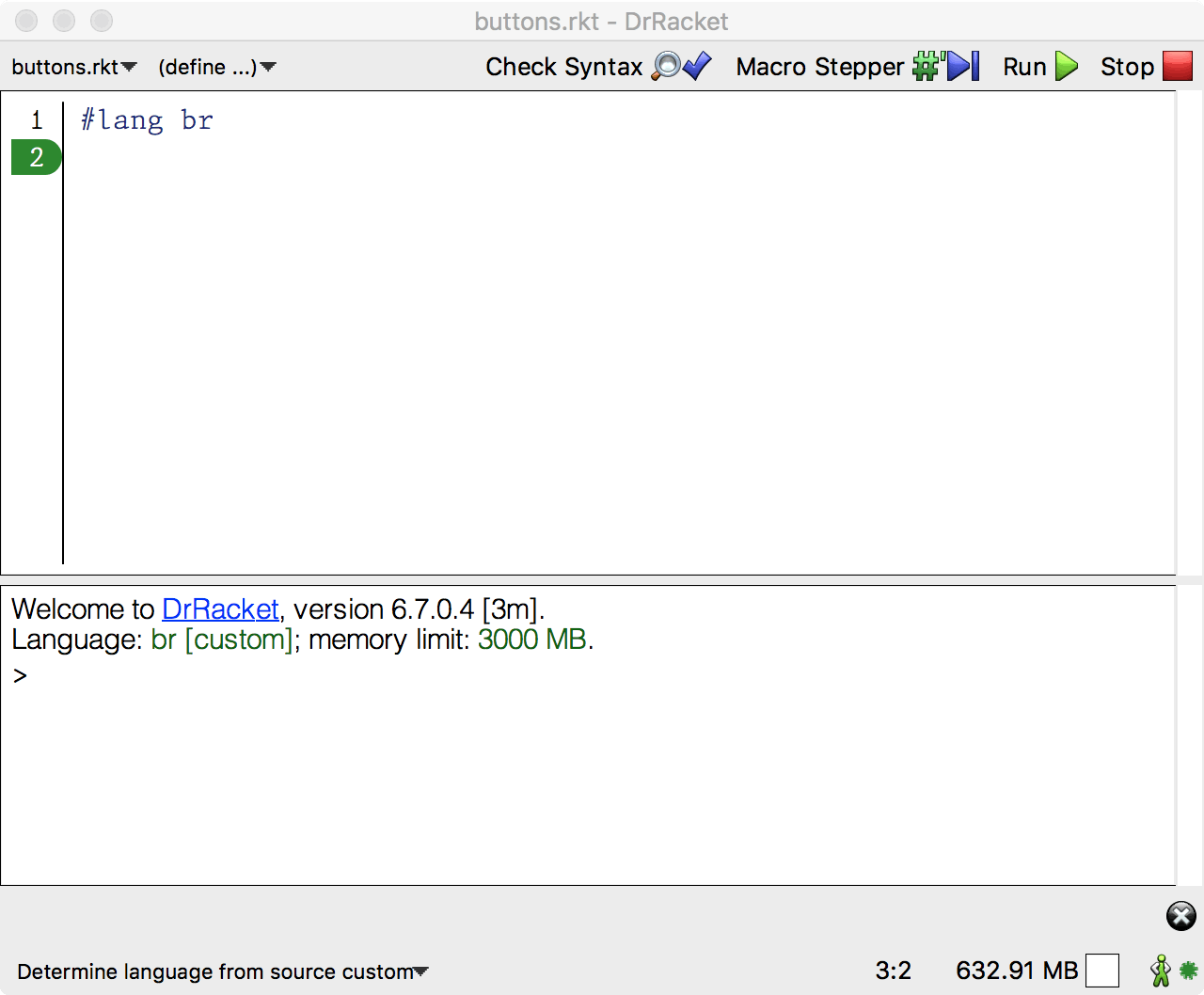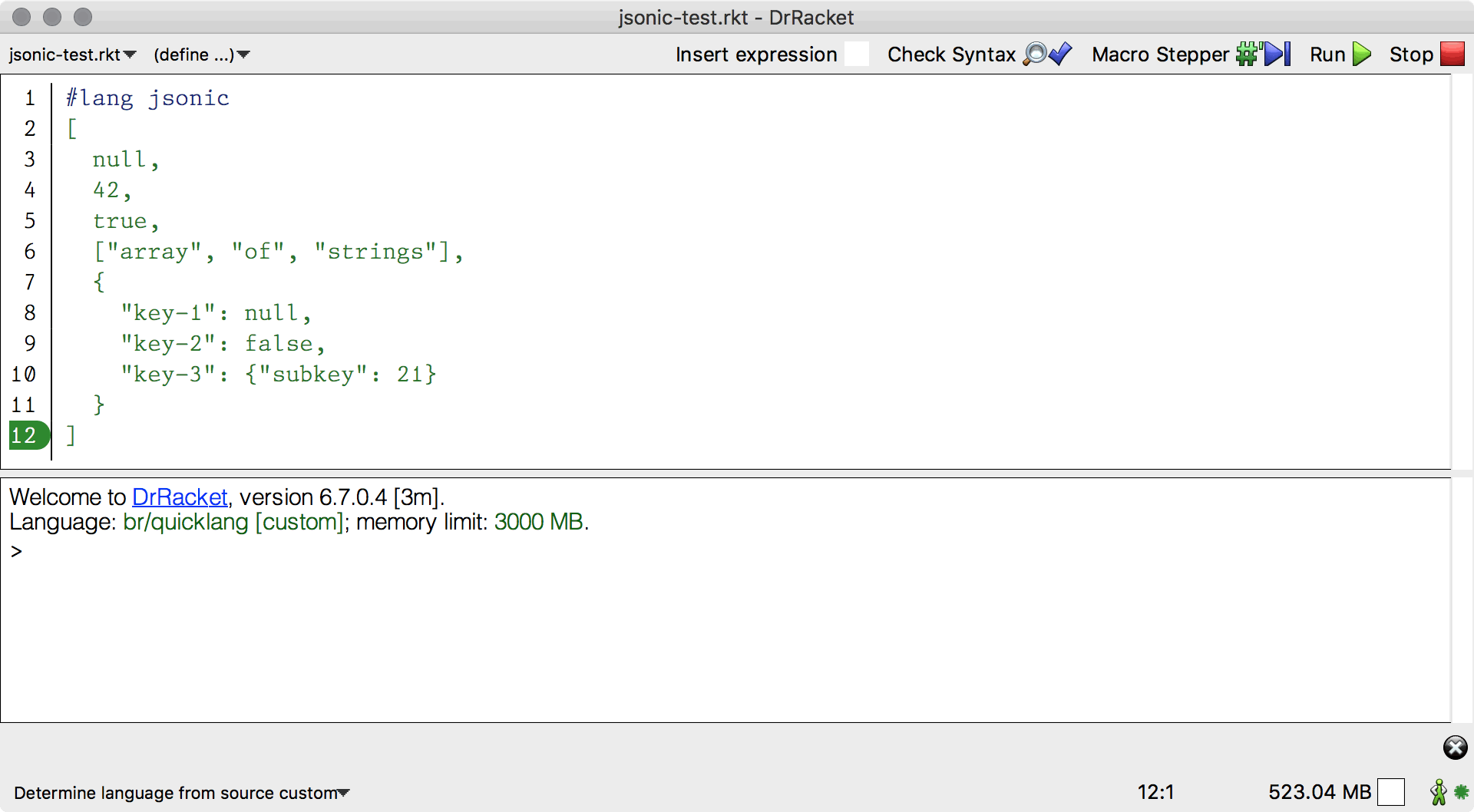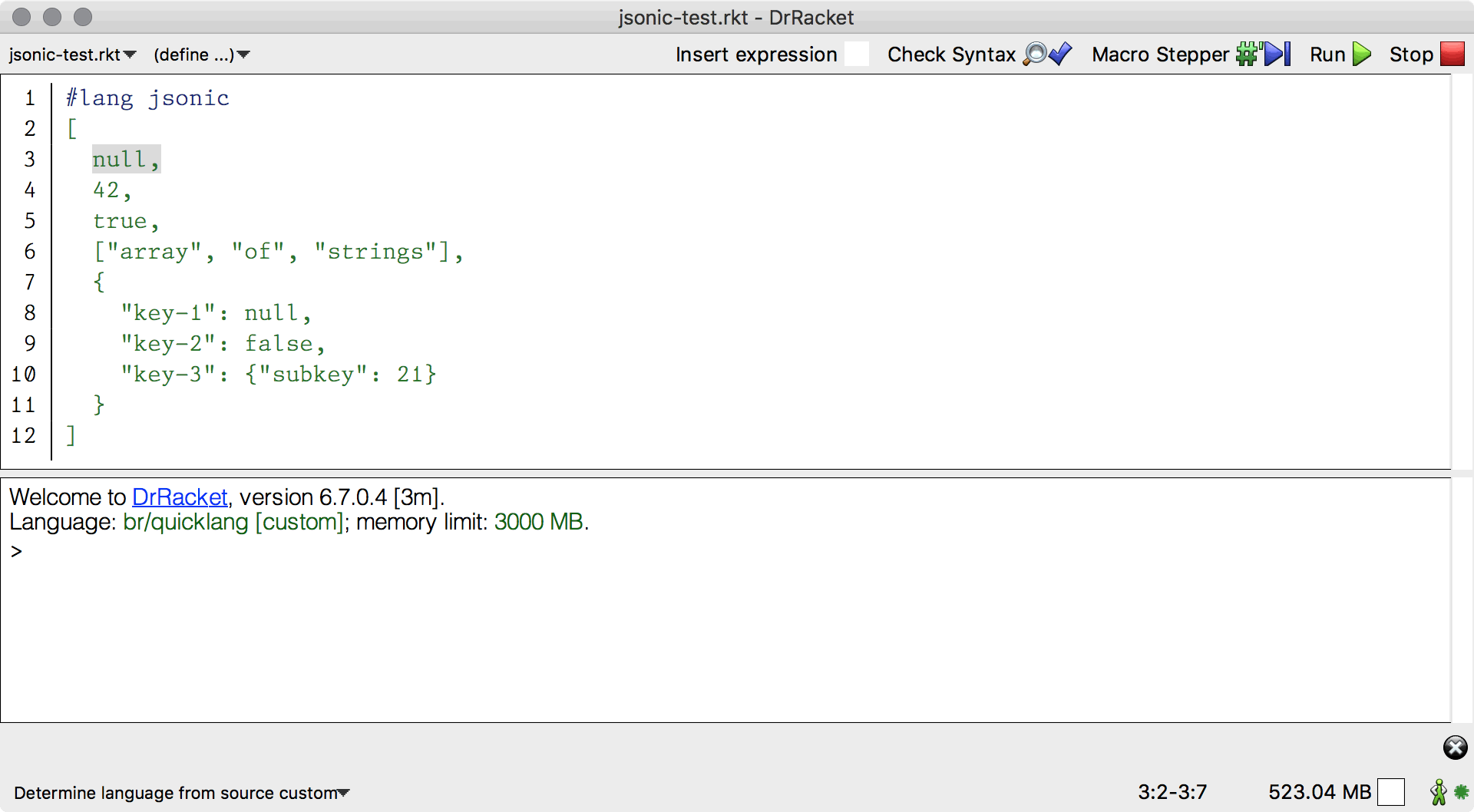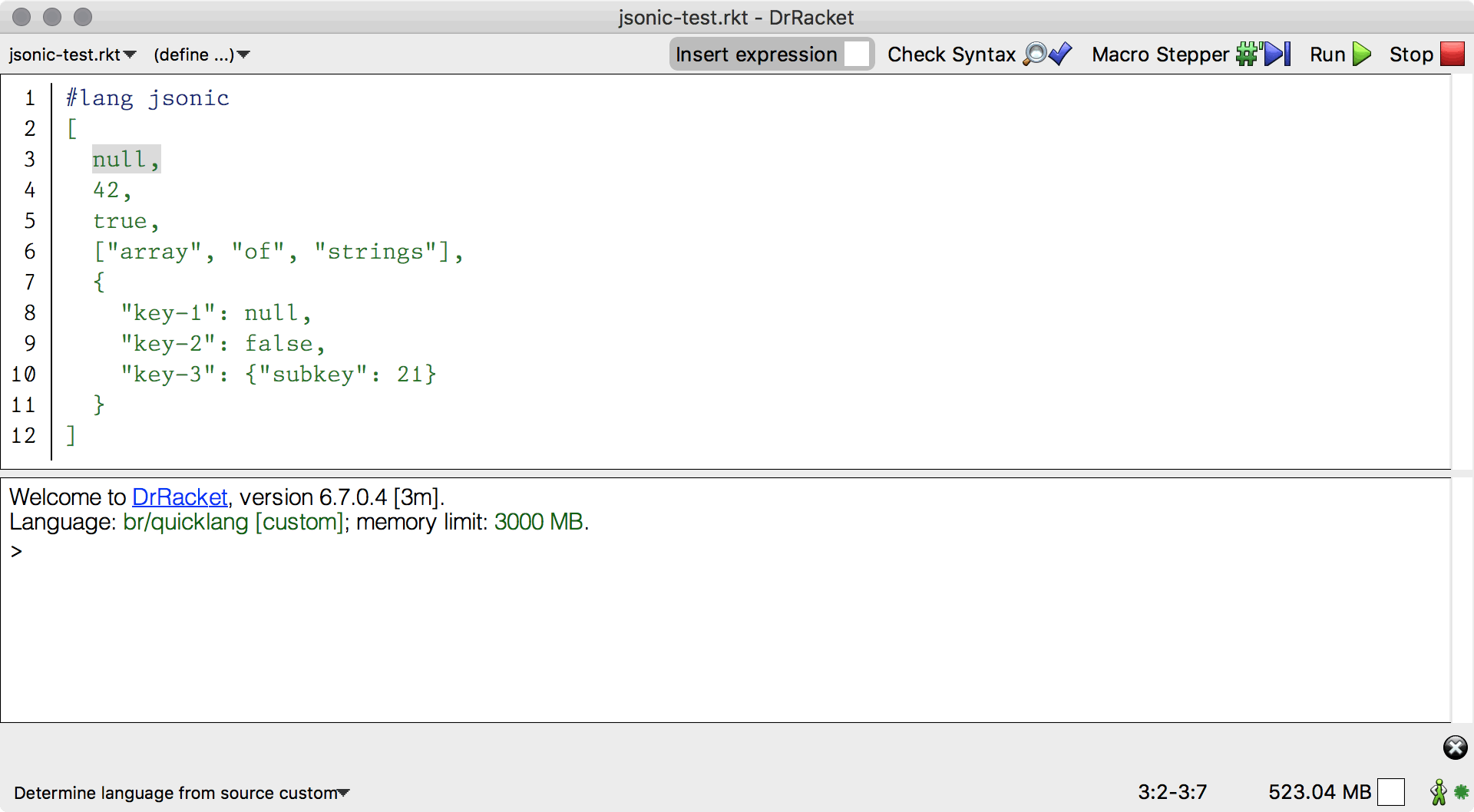Beautiful Racket / tutorials
- 1 intro
- 2 setup
- 3 contracts
- 4 unit tests
- 5 source locations
- 6 drracket integration
- 7 syntax coloring
- 8 indenting
- 9 toolbar buttons
- 10 recap
- 11 source listing
jsonic/main.rkt
#lang br/quicklang
(module reader br
(require "reader.rkt")
(provide read-syntax get-info)
(define (get-info port src-mod src-line src-col src-pos)
(define (handle-query key default)
(case key
[(color-lexer)
(dynamic-require 'jsonic/colorer 'color-jsonic)]
[(drracket:indentation)
(dynamic-require 'jsonic/indenter 'indent-jsonic)]
#;[(drracket:toolbar-buttons)
(dynamic-require 'jsonic/buttons 'button-list)]
[else default]))
handle-query))
(module reader br
(require "reader.rkt")
(provide read-syntax get-info)
(define (get-info port src-mod src-line src-col src-pos)
(define (handle-query key default)
(case key
[(color-lexer)
(dynamic-require 'jsonic/colorer 'color-jsonic)]
[(drracket:indentation)
(dynamic-require 'jsonic/indenter 'indent-jsonic)]
#;[(drracket:toolbar-buttons)
(dynamic-require 'jsonic/buttons 'button-list)]
[else default]))
handle-query))
1 2 3 4 5 6 7 8 9 10 11 12 13 14 15 | #lang br/quicklang (module reader br (require "reader.rkt") (provide read-syntax get-info) (define (get-info port src-mod src-line src-col src-pos) (define (handle-query key default) (case key [(color-lexer) (dynamic-require 'jsonic/colorer 'color-jsonic)] [(drracket:indentation) (dynamic-require 'jsonic/indenter 'indent-jsonic)] #;[(drracket:toolbar-buttons) (dynamic-require 'jsonic/buttons 'button-list)] [else default])) handle-query)) |
jsonic/buttons.rkt
jsonic/buttons.rkt
jsonic/buttons.rkt
#lang br
(require racket/draw)
(define our-jsonic-button
(list
"Insert expression"
(make-object bitmap% 16 16) ; a 16 x 16 white square
···
#f))
(provide button-list)
(define button-list (list our-jsonic-button))
(require racket/draw)
(define our-jsonic-button
(list
"Insert expression"
(make-object bitmap% 16 16) ; a 16 x 16 white square
···
#f))
(provide button-list)
(define button-list (list our-jsonic-button))
jsonic/buttons.rkt
#lang br
(require racket/draw)
(define (button-func drr-window)
(define expr-string "@$ $@")
(define editor (send drr-window get-definitions-text))
(send editor insert expr-string)
(define pos (send editor get-start-position))
(send editor set-position (- pos 3)))
(define our-jsonic-button
(list
"Insert expression"
(make-object bitmap% 16 16)
button-func
#f))
(provide button-list)
(define button-list (list our-jsonic-button))
(require racket/draw)
(define (button-func drr-window)
(define expr-string "@$ $@")
(define editor (send drr-window get-definitions-text))
(send editor insert expr-string)
(define pos (send editor get-start-position))
(send editor set-position (- pos 3)))
(define our-jsonic-button
(list
"Insert expression"
(make-object bitmap% 16 16)
button-func
#f))
(provide button-list)
(define button-list (list our-jsonic-button))
1 2 3 4 5 6 7 8 9 10 11 12 13 14 15 16 17 18 19 | #lang br (require racket/draw) (define (button-func drr-window) (define expr-string "@$ $@") (define editor (send drr-window get-definitions-text)) (send editor insert expr-string) (define pos (send editor get-start-position)) (send editor set-position (- pos 3))) (define our-jsonic-button (list "Insert expression" (make-object bitmap% 16 16) button-func #f)) (provide button-list) (define button-list (list our-jsonic-button)) |
jsonic/main.rkt
#lang br/quicklang
(module reader br
(require "reader.rkt")
(provide read-syntax get-info)
(define (get-info port src-mod src-line src-col src-pos)
(define (handle-query key default)
(case key
[(color-lexer)
(dynamic-require 'jsonic/colorer 'color-jsonic)]
[(drracket:indentation)
(dynamic-require 'jsonic/indenter 'indent-jsonic)]
[(drracket:toolbar-buttons)
(dynamic-require 'jsonic/buttons 'button-list)]
[else default]))
handle-query))
(module reader br
(require "reader.rkt")
(provide read-syntax get-info)
(define (get-info port src-mod src-line src-col src-pos)
(define (handle-query key default)
(case key
[(color-lexer)
(dynamic-require 'jsonic/colorer 'color-jsonic)]
[(drracket:indentation)
(dynamic-require 'jsonic/indenter 'indent-jsonic)]
[(drracket:toolbar-buttons)
(dynamic-require 'jsonic/buttons 'button-list)]
[else default]))
handle-query))
1 2 3 4 5 6 7 8 9 10 11 12 13 14 15 | #lang br/quicklang (module reader br (require "reader.rkt") (provide read-syntax get-info) (define (get-info port src-mod src-line src-col src-pos) (define (handle-query key default) (case key [(color-lexer) (dynamic-require 'jsonic/colorer 'color-jsonic)] [(drracket:indentation) (dynamic-require 'jsonic/indenter 'indent-jsonic)] [(drracket:toolbar-buttons) (dynamic-require 'jsonic/buttons 'button-list)] [else default])) handle-query)) |




